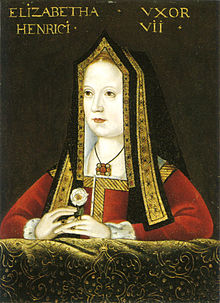
Elizabeth of York was crowned a little more than two years after her husband, Henry VII. Although she was widely regarded as the Yorkist heir to the throne, Henry did not want to condition his legitimacy on her claim so he insisted on being crowned himself before their marriage – and then Elizabeth’s coronation had to wait because she was pregnant with their first child (Prince Arthur was born on September 20, 1486).
On the 24th, she rode through London to Westminster. The crowd was immense as it was her first public appearance since her marriage, and everyone was anxious to behold her. Apparently, she did not disappoint. As Agnes Strickland puts it in her wonderful Lives of the Queens of England,
[S]he had not completed her twenty-second year, her figure was, like that of her majestic father, tall and elegant, her complexion brilliantly fair and her serene eyes and perfect features were now lighted up with the lovely expression maternity ever gives to a young woman whose disposition is truly estimable. The royal apparel, in which her loving subjects were so anxious to see her arrayed, consisted of a kirtle of white cloth of gold, damasked and a mantle of the same, furred with ermine, fastened on the breast with a great lace or cordon, curiously wrought of gold and silk, finished with rich knobs of gold and tassels. ‘On her fair yellow hair, hanging at length down her back, she wore a caul of pipes and a circle of gold, richly adorned with gems.'”
Then, on the day itself, she was even more majestic – and provoked a near-riot:
“The next day she was attired in a kirtle of purple velvet, furred with ermine bands in front. On her hair she wore a circlet of gold, set with large pearls and colored gems. She entered Westminster Hall with her attendants, and waited under a canopy of state till she proceeded to the abbey. The way thither was carpeted with striped cloth, which sort of covering had been, from time immemorial, the perquisite of the common people. But the multitude in this case crowded so eagerly to cut off pieces of the cloth, ere the queen had well passed, that before she entered the abbey several of them were trampled to death, and the procession of the queen’s ladies “broken and distroubled.”
Elizabeth’s mom, Elizabeth Woodville, was not present – she was suspected of having been involved in the 1487 Yorkist rebellion that claimed that Lambert Simnel was the true king of England and was sent to remote Bermondsey Abbey where she took up a quiet, contemplative life. Elizabeth’s step-brother Thomas Grey, Earl of Huntingdon and Marquess of Dorset, had been caught up in that same rebellion and sent to the Tower, but was liberated and allowed to assist the coronation. Part of the reconciliation, after all!
***
If you like my posts, you’ll love my books! Jane the Quene and The Path to Somerset have finally been joined by The Boy King – now available through Amazon, Barnes & Noble, Kobo, and Apple!

(What? You haven’t read Jane the Quene or Path to Somerset yet? Please do! And equally important – please leave a review – even just a star rating! It makes a huge difference in helping new readers find them and would mean the world to me!)

Be First to Comment